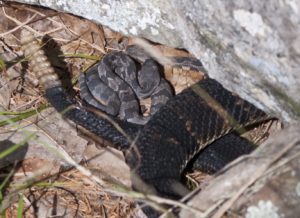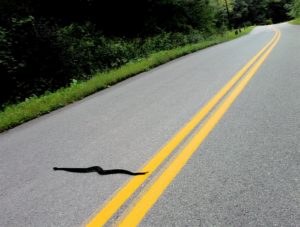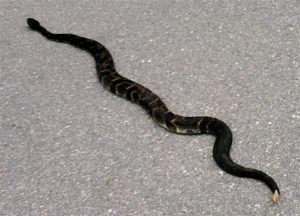Crotalus horridus
Identification 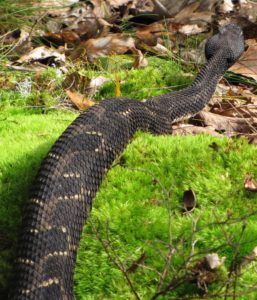
The Timber Rattlesnake has black W-shaped cross bands on a tan, yellow, or dark brown background. They have a black tail and the rattle on the end of the tail is a yellowish-tan color. Timber Rattlesnakes may have a yellow head, in which case they generally have a brightly patterned body, or they may have a black head, in which case they have a darker patterned body.
The rattlesnake is a thick snake usually 2-4 feet in length (the longest documented in Vermont is 54 inches), with heavily keeled scales.
This is Vermont’s only venomous snake. It is not at all aggressive but it should not be handled.
Get more detailed identification and life history information by downloading the chart here.
You can learn more about this species and see some video footage by checking out this short clip or this longer focused clip on the species from our Rattlers, Peepers & Snappers DVD.
Vermont’s Rattlesnake Response Program is a FREE service that aims to protect Vermont residents and Timber Rattlesnakes by safely moving nuisance rattlesnakes away from private and public property. Learn more at this page.
Range/Habitat
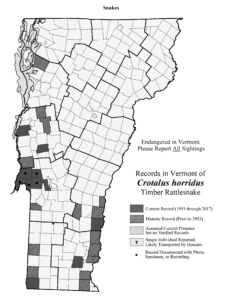
[ click image to zoom | download printable PDF ]
Timber Rattlesnakes inhabit rock slides, ledges, and nearby deciduous (oak-hickory) woodlands.
Before You Report a Rattlesnake
One hundred percent of the rattlesnake reports that we have checked up on, outside of a few in Western Rutland County, were actually Eastern Milksnakes. Eastern Milksnakes have an eye-catching pattern, and they rattle, coil, and strike. This behavior is a bluff, but it convinces many people that they are hearing and seeing rattlesnakes when they really are looking at a Milksnake. Instead of a shaking tail, a rattling sound, or a striking pattern, look for the solid black tail, solid black or yellow head, and a large and obvious segmented, yellowish brown rattle at the end of the tail. If you see a blotched pattern and hear a rattle or see a snake shaking its tail, it is probably a Milksnake. If you see a segmented rattle at the end of a black tail, it is a rattlesnake.
Status
This species has a state natural heritage rank of S1 (rare). The Timber Rattlesnake has been designated a Species of Greatest Conservation Need (high priority) in Vermont’s Wildlife Action Plan and is endangered in Vermont. Please report all sightings of this species in Vermont. Take photos if possible. Even historic sighting information is useful.
Additional Photos
More Info
- Crotalus horridus at the Animal Diversity website
- Crotalus horridus at the Canadian Herpetological Society website
- Crotalus horridus in the Vermont Agency of Natural Resources’ Wildlife Action Plan: Amphibian & Reptiles (9/25/2015 draft)
- Crotalus horridus at the Snakes of Massachusetts website
- Crotalus horridus Department of Defense PARC species profile video series
Species summary written by Ariel K. McK. Burgess.



